How a Conversation Led to First Aid Kits
Sometimes a chance conversation can lead to unexpected things. In Johnson & Johnson history, conversations have led to some very well-known products from our Family of Companies. A conversation in the late 1800s between one of our founders and someone he met on vacation led to something that’s a part of modern life: The First Aid Kit. Here’s how it happened.
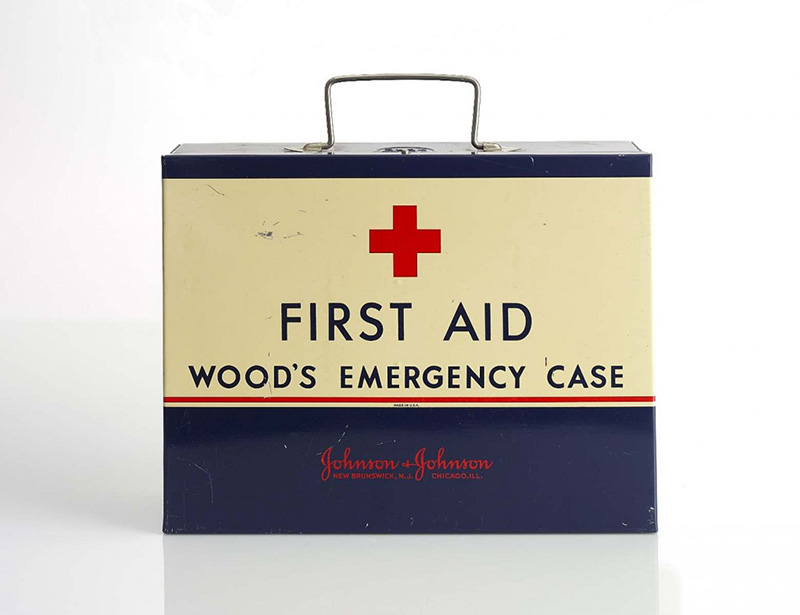
One day in the late 1880s, Company founder Robert Wood Johnson was on a Denver & Rio Grande train heading west through the Rocky Mountains, on his way to a much anticipated vacation. He was planning to spend that vacation at a Colorado cattle ranch.
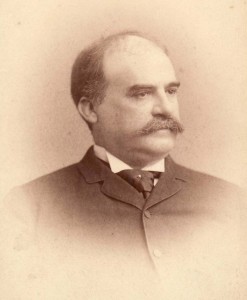
Robert Wood Johnson was an outgoing person, and he struck up a conversation with the railway surgeon on the train. In the 1880s, according to this site on the history of railway surgeons, railway surgeons were usually general practitioners who had some experience doing surgery. Theirs was a tough job and they were hampered by the lack of sterile medical supplies and the fact that they often had to work outdoors, miles from any kind of medical facilities. The Denver & io Grande railway surgeon, when he discovered what business Robert Wood Johnson was in, realized he had a sympathetic listener and he began telling Johnson about the frequent injuries to railroad workers laying track.
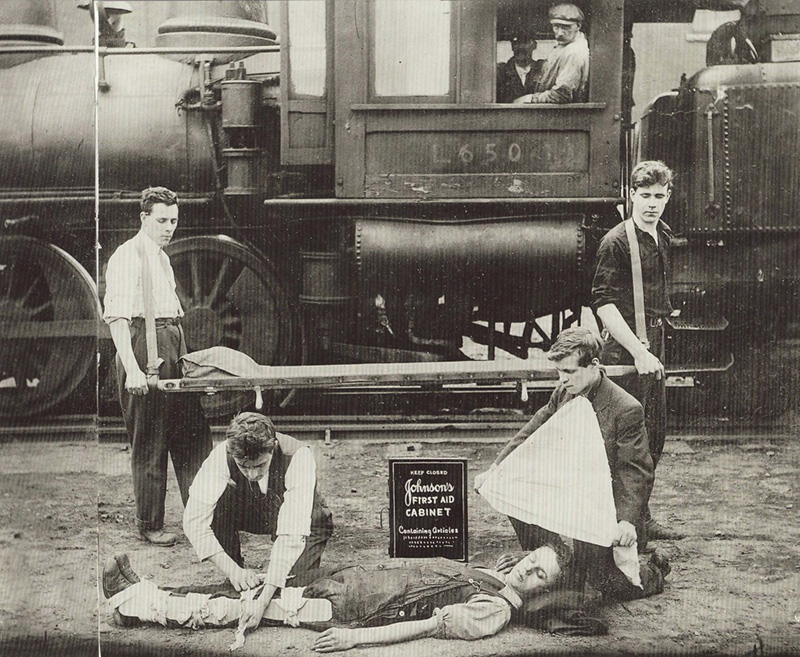
Building the railroads was a grueling job. When injuries occurred, medical care and good, reliable medical supplies were often too far away to do any good. Johnson’s philosophy was to produce products that met unmet needs in society, and he had an idea. What if Johnson & Johnson packaged its sterile surgical gauze, dressings and other products together in boxes that could be kept on trains and at the sites where the workers were working? The railway surgeons would then have the supplies they needed to treat and stabilize the injured so that they could be transported to more comprehensive medical help. If anyone is interested in seeing the kinds of railroad work Robert Wood Johnson and the Denver & Rio Grande railways surgeon talked about, this site has an 1896 Thomas Edison film of railroad workers laying track for the Black Diamond Express.
So Johnson & Johnson wrote to railway surgeons across the country to ask their opinions and advice as to what types of medical supplies were needed. Here’s an excerpt one of those letters, from June 8, 1888:
“We are about to get up a railway emergency case, and wish to make one that will be of real service in the field it is intended for…it is our wish to get suggestions from practical railroad surgeons. We already have them from one of two of the surgeons of the largest western railroads.” [Letter from our archives dated June 8, 1888, signed “Johnson & Johnson.”]
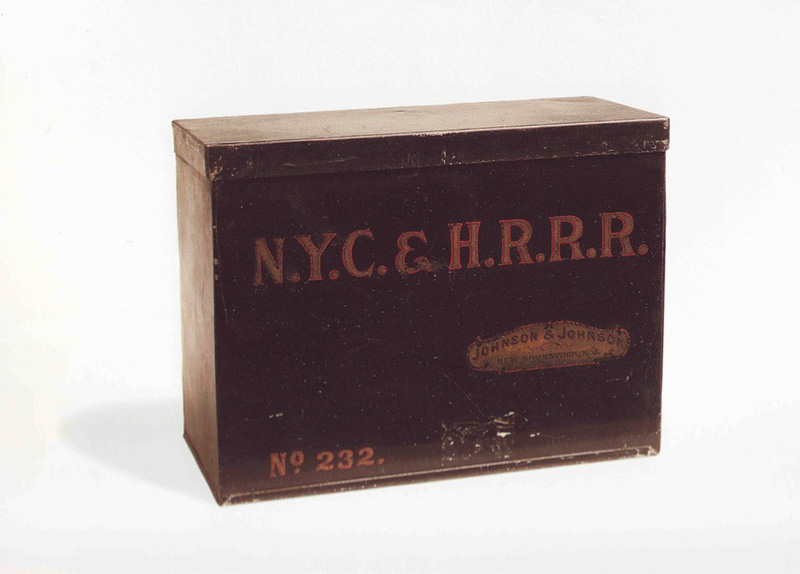
In 1890 The Company put out a kit called the Railway Station and Factory Supply Case, which was (as the name suggested) designed to be placed with railroad station agents and used in factories. Here’s an 1891 advertisement for the kit:
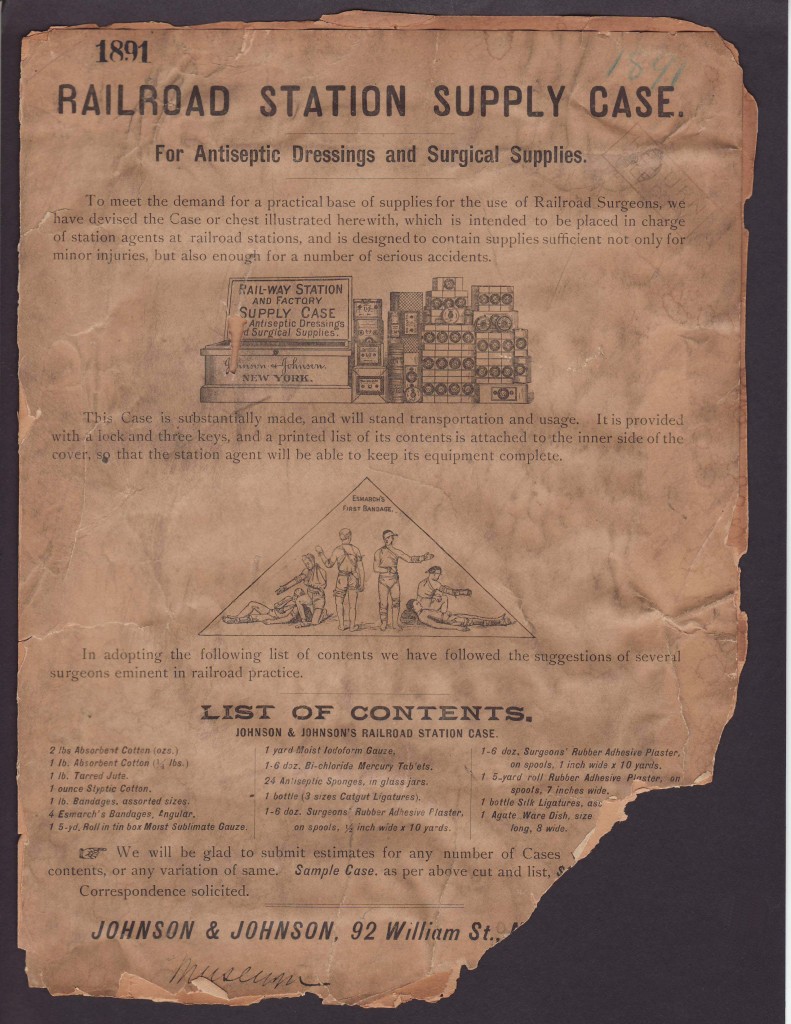
“To meet the demand for a practical base of supplies for the use of Railroad Surgeons, we have devised the Case or chest illustrated herewith, which is intended to be placed in charge of station agents at railroad stations, and is designed to contain supplies sufficient not only for minor injuries, but also enough for a number of serious accidents…In adopting the following list of contents we have followed the suggestions of several surgeons eminent in railroad practice.” [Johnson & Johnson ad for Railroad Station Supply Case, 1891, from our archives.]
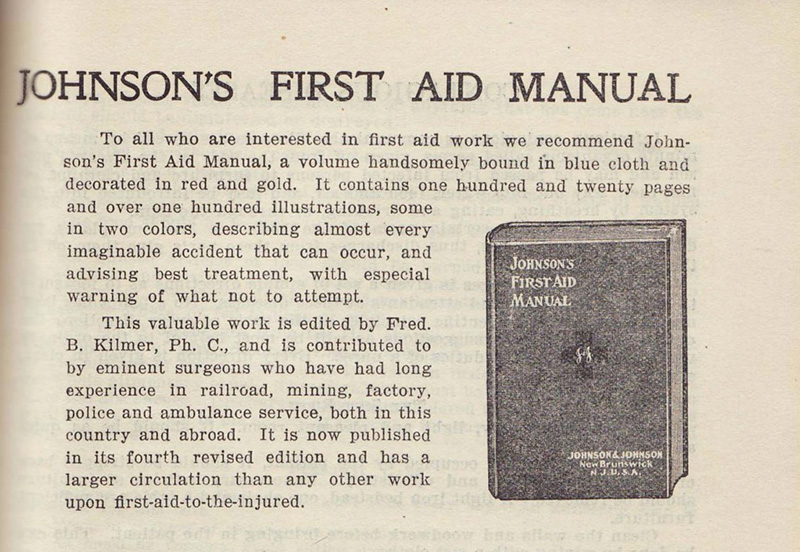
Fred Kilmer began researching best practices in First Aid, again reaching out to doctors and surgeons for information…and in 1901, Johnson & Johnson published the first First Aid Manuals, which were packaged with the kits. An uncredited writer on the early manuals was Kilmer’s son, the poet Joyce Kilmer. The manuals provide comprehensive instructions, based on input from physicians, on how to provide “first aid” for a variety of injuries until the doctor could arrive.
The Johnson & Johnson First Aid Kits filled a huge unmet need, and soon public buildings, manufacturing sites and homes began have First Aid Kits. The Company made large First Aid kits that were designed for workplaces, and small travel-sized kits that fit into a pocket for people to carry with them. In 1898, during the Spanish-American War, Johnson & Johnson made small kits for soldiers that could be carried in their packs or pockets.
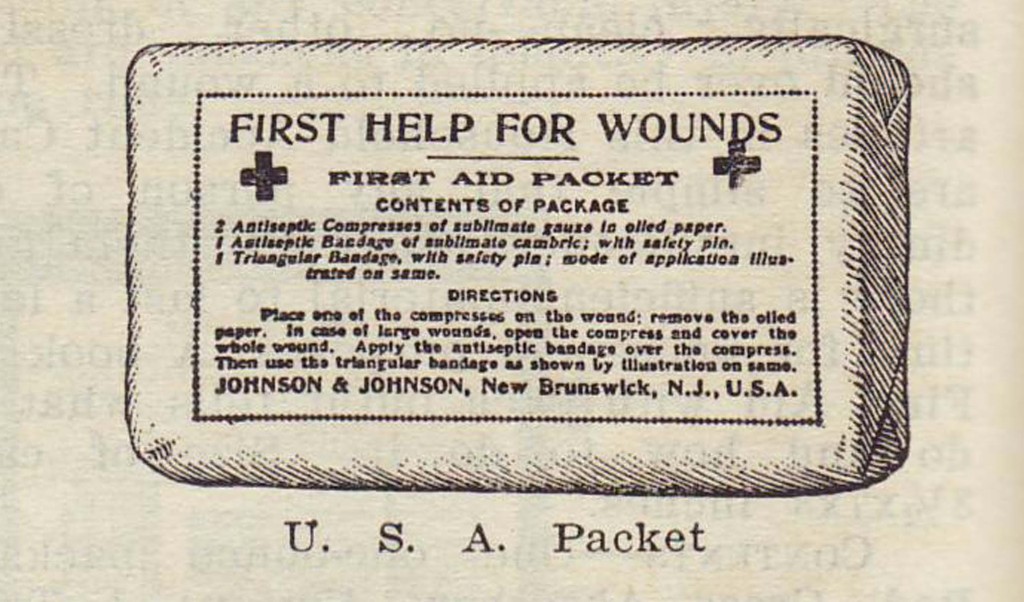
An August 28, 1890 listing of contents for the Company’s First Aid Kits mentioned at the top that it was “Recommended by the National Convention of Factory Inspectors” and listed 18 different varieties of First Aid Kits -- all with different combinations of contents, depending on the need the kit was to fill. All of the kits contained sterile gauze and cotton and sterile dressings. Some contained an Esmarch bandage. Others had sterile sutures and antiseptic sponges, as well as antiseptic tablets for use in sterilizing equipment.
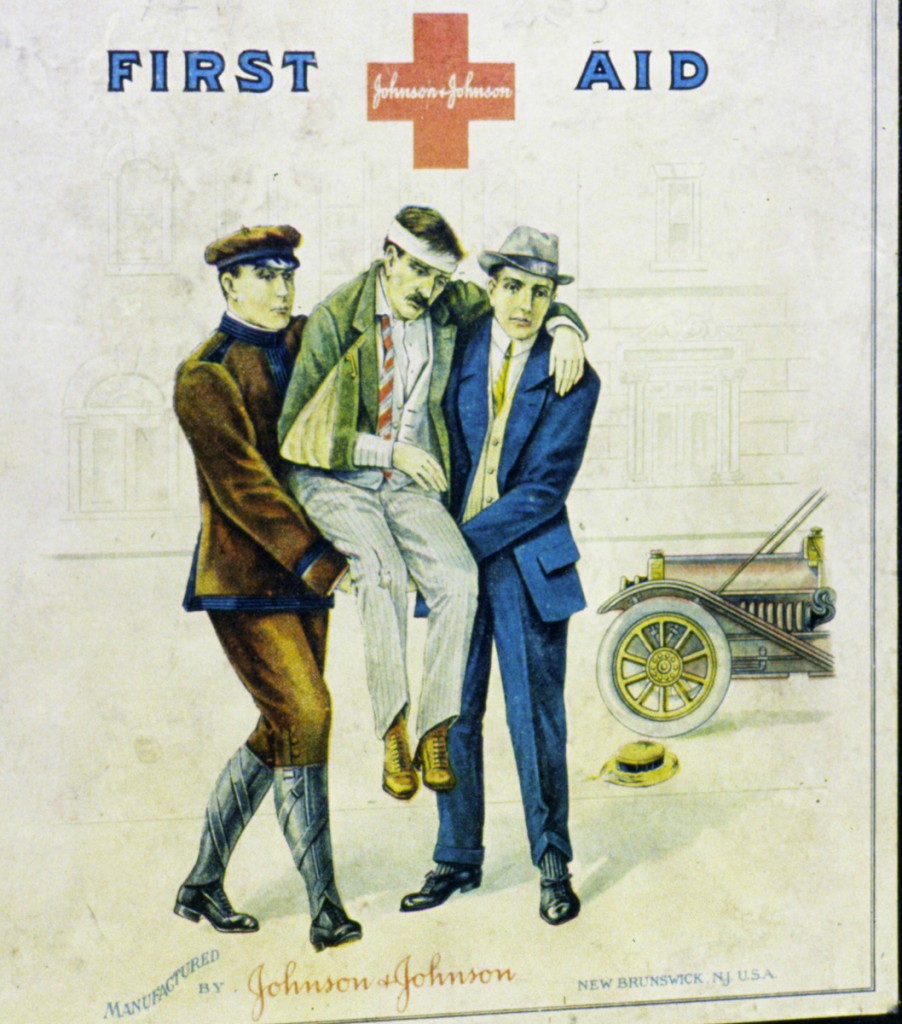
When the earliest automobiles became popular, Johnson & Johnson produced Autokits, which were (as readers may already have guessed) First Aid Kits designed for use in automobiles. When airplanes came into use, the Company produced Aerokits, designed for airplanes. A Johnson & Johnson First Aid Kit was even part of the essential equipment on this historic flight.
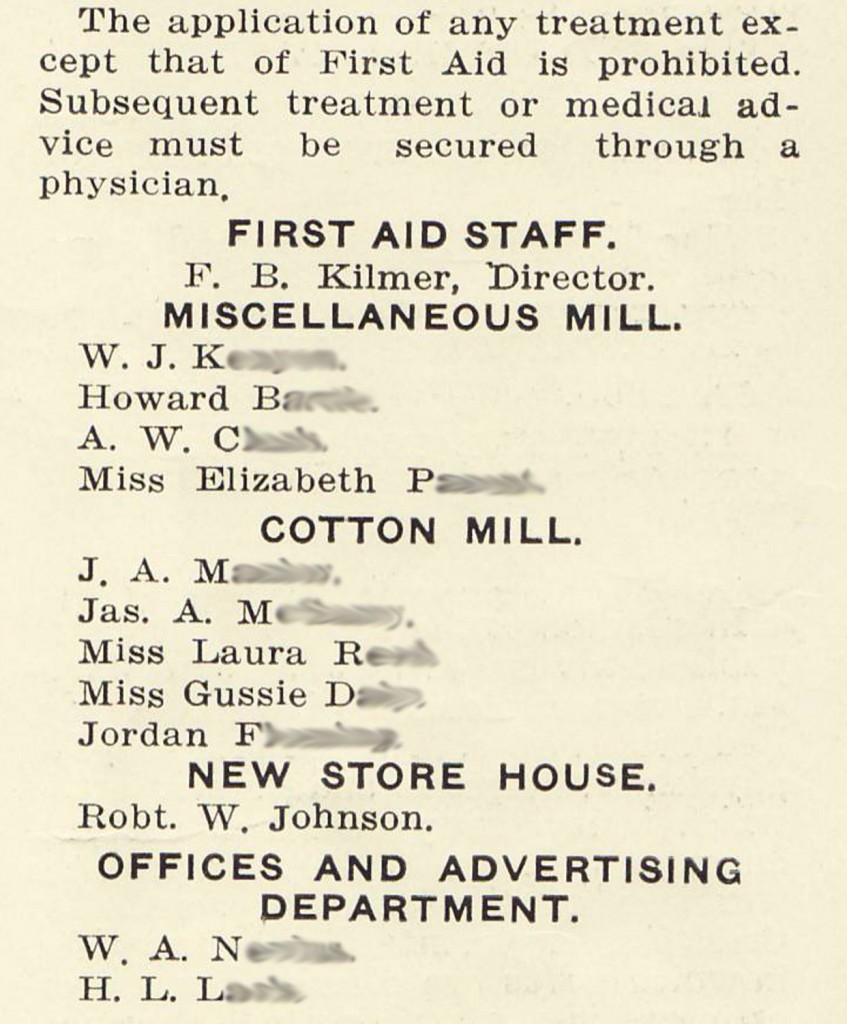
Johnson & Johnson trained employees in First Aid and formed an employee First Aid staff under the direction of Fred Kilmer. In 1912, the future General Robert Wood Johnson was a member of that First Aid staff. His area of responsibility as a trained responder was the Company’s new store house.
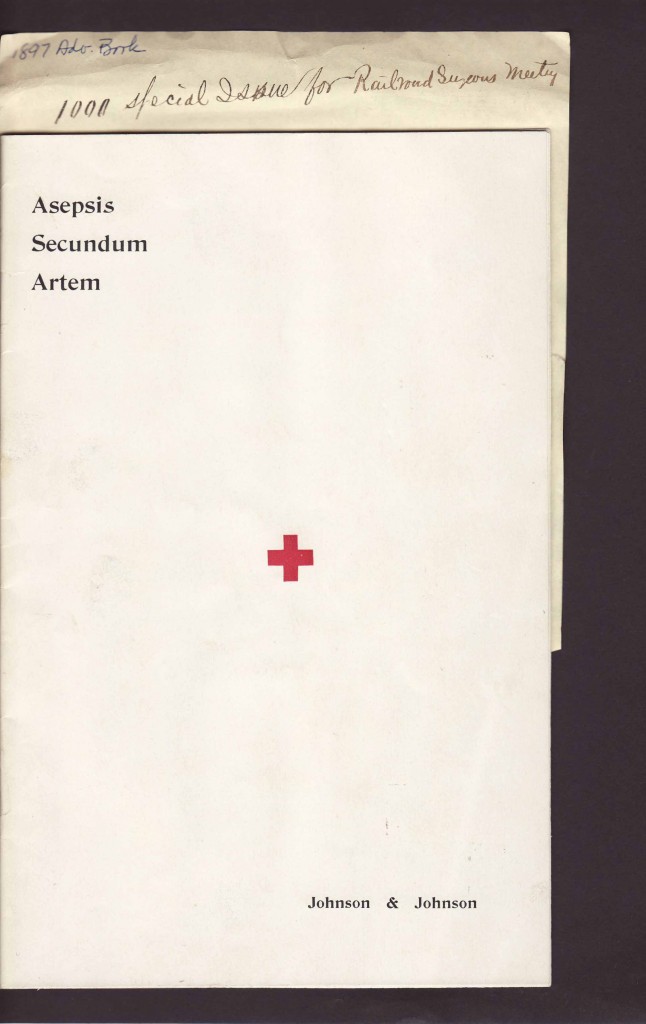
In 1897, the National Association of Railway Surgeons held their tenth annual convention in Chicago, Illinois. Johnson & Johnson had an exhibit there, and the Company prepared a special issue of Aseptis Secundum Artem (our 1897 publication about the preparation of aseptic dressings) for the railway surgeons at the meeting.
Today, First Aid Kits and manuals are so much a part of modern workplaces, public buildings, homes, cars, schools, camping trips and more that it’s hard to imagine a time before they existed. The absence of reliable medical supplies and science-based information in treating injuries was once a huge unmet need in society, one that was filled as a result of a very fortuitous conversation.

Neat Story! I'm a lifescan employee and I have to say I never really thought about where the first aid kit came from.... until now.
Great info. I have a complete Johnson's #10 kit, would love to know when that was made. Thanks.
In reply to by Pat Carney
Pat,
Without a photograph of your #10 First Aid Kit, it's hard to give you a date. Please send me a photo of your kit through the blog's mailbox, and I will be happy to give you information regarding the date. The email address is: [email protected]
Margaret
I've come across a triangular bandage like the one in the photo of the Railroad Station supply case. Chapter 138 "How a conversation lead to first aid kits" Mine has in addition on it between the two standing figures picture of how to get something out of an eye and also how to stop bleeding of the arm and leg using hand with pressure points and the bandage as a tourniquet. I'm interested in about what year this one was manufactured. It must be newer with the added photo's than the one above. I want to know the date and what I can. It's a great teaching tool to use for Boy Scouts.
In reply to by Cathe Bruno
Hi Cathe, Your triangular bandage is a very famous first aid product, the Esmarch Triangular Bandage, which was invented by a European physician during the Franco-Prussian War in 1870. It was designed for battlefield first aid, and the instructions were printed on the bandage so that they could not get lost during times of great stress. The instructions also were visual, and they could be understood by people who spoke various languages, or who had varying degrees of literacy. Here's the link to a Kilmer House post with more information about the Esmarch Triangular Bandage: http://www.kilmerhouse.com/2010/10/product-instructions-you-cant-lose/ Without a picture, I'm not able to tell approximately when your Esmarch bandage is from. If you can send me a photo through the blog's email at [email protected], I will be able to take a look and possibly identify a date range for you. Margaret
i recently came across a blue and white johnsons autokit first aid outfit made in garave,yorks england.it still contains all its medical items.i would like to know what year is it from and if it is a car first aid kit thank you for your time rebecca shell
Hi Margaret:
How come the family names of the Company's first first aid team are blurred except for Johnson & Kilmer? Is it because of today's privacy?
James
In reply to by James Bergin
James,
It is indeed because of privacy, since the others are not public figures like Robert Wood Johnson and Fred Kilmer!
Margaret
Hi Rebecca,
Without seeing a photo of your first aid Autokit, it's hard to tell, but if the tin is metal, then it sounds as if your First Aid Autokit may be from the 1930s. Before that time, the kits were black rather than blue and white. If you can send me a photo of your kit through the blog's mailbox (which is [email protected]) I will be happy to take a look and give you more information on it!
Margaret
Ms. Margaret,
I am writing a college paper and I see that your first name is listed for the article above but not your last name. I was just going to ask for your last name so that my works cited page would be more accurate.
Thank you,
Mrs. Morgan
Hi Rachel,
My last name is Gurowitz. Happy that the blog is helping you with a college paper, and best of luck on your paper!
Margaret
I have 2 old Johnson & Johnson metal 1st aid kits.
1) One has Johnson's Travelkit First-Ait Outfit printed in red and blue on the upper half of the tin (white background), and Johnson & Johnson (Gt. Britain) Ltd. Slough Made in England printed in white on the lower half (blue background.) There are 6 packages inside - 1 roll Absorbent lint, 2 rolls W.O.W. Bandage B.P. C. 2in x 4 yds, 2 rolls W.O.W. Bandage B.P. C. 1in x 3 yds, 1 roll W.O.W. Bandage B.P. C. 1in x 4 yds. All of the WOW Bandage rolls are still sealed in the paper packaging/wrap, the Absorbent Lint package has been opened, but doesnt appear to have been used or cut.
2) The second kit has the same printed info on the bottom/blue half of the tin front. The upper half (white background) has the Johnson's (red) and AutoKit First-Aid Outfit. Not sure how much of the contents are original to this kitmmbut it does have 1 roll of J&J Absorbent Cotton Wool, 1 W.O.W. Bandage 2 inches x 6 yds., and 1 Triangular Bandage in the Gt. Britain, Slough Made in England wrappers - still sealed. In addition there is a small box with 3 ampules of Sp. Ammon. Aromat. B.P. (box says there were 4 ampules inside but I only have 3), a woven belt-type strip with buckle (for the triangular bandage?), 1 roll of Zonas Adhesive Plaster (Gt Britain etc printed on it), 1 roll of J&J Adhesive tape (made in USA), a Giant Styptik Pen (red wrapper on pen, cant read mfr info. made in Brooklyn NY) in a plastic tube with tin lid, a bottle of Tincture of Merthiolate No. S16 (Eli Lily Co.), a pair of scissors, tweezers and file, and a yellow/brown tin of Bayer Aspirin).
Wondering when they may have been produced? Possible current value?
Thanks!
In reply to by MAureen
Hi Maureen,
Without seeing your First Aid Kits, it's difficult to tell, but from your description it sounds like they are from the 1930s at the oldest, and the late 1950s at the most recent. If you're able to send me photos of your kits through the blog's email -- [email protected] -- I will take a look and will be able to give you a better idea.
Margaret
I have to say, I am very excited about coming across your webpage! And learning something new in how the travel kit came to be.
Also, give me hope on finding the time period from which my little tin kit came from (as I have emailed you). :)
i found a first aid travel kit (blue and white ) which contained 2 things of redcross bandages adhesive tape made with formula 87? (orange white and green) some Unguentine 1.14 ounces back said at the bottom ''Norwich'' colr was ( cream,black,and red) and a small bottle with a rubber cork..''Methcuronrome'' (red liquid) on side it said MD-175..
Then another bottle square black lid also (red liquid) looks like a letter is missing but what i can read it says ''Ercurochron''
and last but not least 4 band-aid plastic strips... what year is this from????
In reply to by Carrie Steakley
Hi Carrie,
Thanks for sending the inquiry! The small bottle with the black lid is Mercurochrome, which was a standard wound care treatment in earlier eras. Without seeing a photo of your First Aid Kit, it's difficult to give you a date. If the Mercurochrome and the BAND-AID® Brand Plastic Strips are original to your First Aid Kit, then it likely dates from the 1950s. If the kit says New Brunswick, New Jersey and Chicago, Illinois on the front, then the kit would be earlier, potentially 1930s or 1940s. If you can email me a photo of your kit at [email protected] I may be able to give you a more precise date.
Margaret